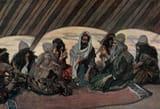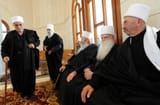Anonymous
7/20/2025, 12:07:20 PM No.17857096
Are the Druze descendants of the Biblical Kenites? Their DNA shows great affinity with Jews, unlike any other Levantine population.
>Also interesting are the results of genetic studies over the past several decades of Middle Eastern and Jewish populations—two studies in particular, which found it “strange that … the Druze, who originated from an Islamic movement at the beginning of the second millennium c.e., were found to be the closest to the Jews,” though no explanation for this was given (Gal Chaimovich, “A Yiddish Genetic,” Hebrew original).
A higher share than either Arab Palestinians, Maronite Christians, or Eastern Jews. There is also this interesting factoid of biblical archaeology:
>Notably, one of the sites associated with this tribe—Horvat Uza (identified with the biblical Kinah)—has a stark absence of the typical anthropomorphic figures found in the region throughout this period. The notable lack of such has been attributed to a remarkable level of “aniconism” in the Kenite community: In the words of Prof. Nadav Na’aman, “the absence of anthropomorphic figurines at the site is exceptional in comparison with other sites all over the kingdom of Judah and may reflect the aniconic tendency of the Kenites” (“The ‘Kenite Hypothesis’ in the Light of the Excavations at Horvat ‛Uza”). Interestingly, one of the key features of the Druze religion is the strict avoidance of iconography.
Given the esoteric nature of their religion, could it be possible that their story of origin in the Fatimid Caliphate be a ruse in it of itself? Are they really an offshoot of Ismaili Shia Islam? Or have they just pretended to be, to avoid persecution? After all, their supposed founder was fabled to have gone into hiding as well. Maybe that is a coded description of the history of the Kenites as well.
https://armstronginstitute.org/1089-children-of-jethro-spotlighting-the-druze-community
>Also interesting are the results of genetic studies over the past several decades of Middle Eastern and Jewish populations—two studies in particular, which found it “strange that … the Druze, who originated from an Islamic movement at the beginning of the second millennium c.e., were found to be the closest to the Jews,” though no explanation for this was given (Gal Chaimovich, “A Yiddish Genetic,” Hebrew original).
A higher share than either Arab Palestinians, Maronite Christians, or Eastern Jews. There is also this interesting factoid of biblical archaeology:
>Notably, one of the sites associated with this tribe—Horvat Uza (identified with the biblical Kinah)—has a stark absence of the typical anthropomorphic figures found in the region throughout this period. The notable lack of such has been attributed to a remarkable level of “aniconism” in the Kenite community: In the words of Prof. Nadav Na’aman, “the absence of anthropomorphic figurines at the site is exceptional in comparison with other sites all over the kingdom of Judah and may reflect the aniconic tendency of the Kenites” (“The ‘Kenite Hypothesis’ in the Light of the Excavations at Horvat ‛Uza”). Interestingly, one of the key features of the Druze religion is the strict avoidance of iconography.
Given the esoteric nature of their religion, could it be possible that their story of origin in the Fatimid Caliphate be a ruse in it of itself? Are they really an offshoot of Ismaili Shia Islam? Or have they just pretended to be, to avoid persecution? After all, their supposed founder was fabled to have gone into hiding as well. Maybe that is a coded description of the history of the Kenites as well.
https://armstronginstitute.org/1089-children-of-jethro-spotlighting-the-druze-community
Replies:



